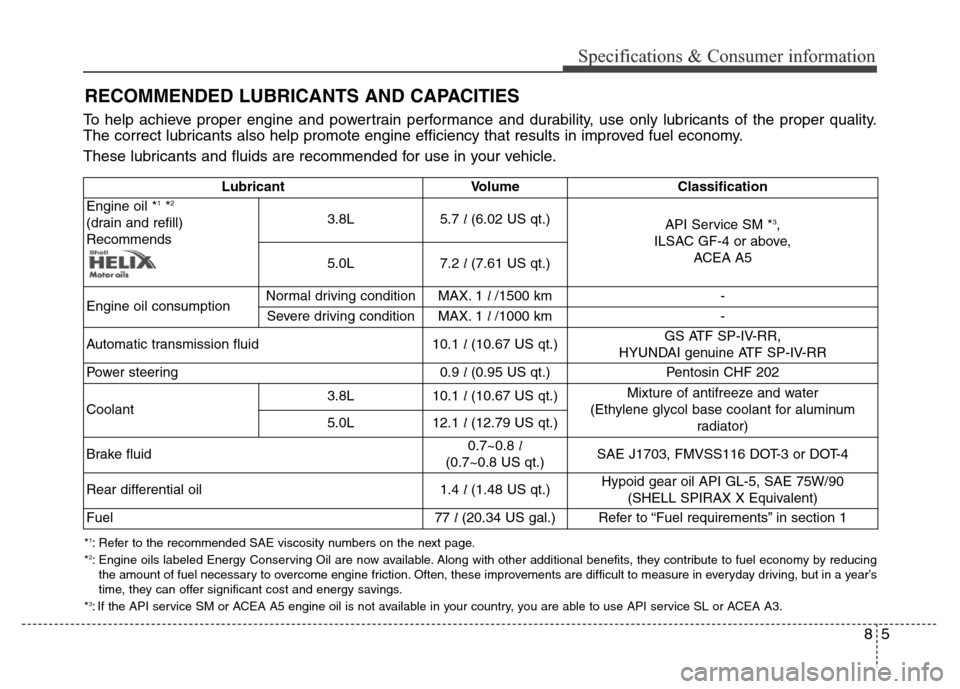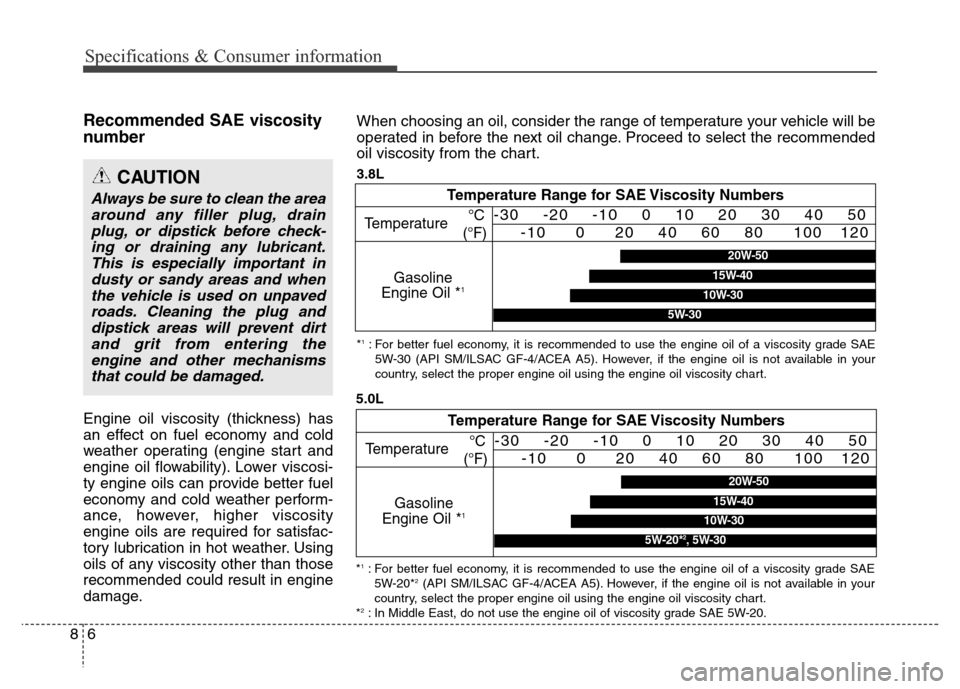Page 426 of 479

741
Maintenance
Remove the valve cap from the tire
valve stem. Press the tire gage firm-
ly onto the valve to get a pressure
measurement. If the cold tire inflation
pressure matches the recommended
pressure on the tire and loading
information label, no further adjust-
ment is necessary. If the pressure is
low, add air until you reach the rec-
ommended amount.
If you overfill the tire, release air by
pushing on the metal stem in the
center of the tire valve. Recheck the
tire pressure with the tire gage. Be
sure to put the valve caps back on
the valve stems. They help prevent
leaks by keeping out dirt and mois-
ture.Tire rotation
To equalize tread wear, it is recom-
mended that the tires be rotated
every 12,000 km (7,500 miles) or
sooner if irregular wear develops.
During rotation, check the tires for
correct balance.
When rotating tires, check for uneven
wear and damage. Abnormal wear is
usually caused by incorrect tire pres-
sure, improper wheel alignment, out-
of-balance wheels, severe braking or
severe cornering. Look for bumps or
bulges in the tread or side of tire.
Replace the tire if you find either of
these conditions. Replace the tire if
fabric or cord is visible. After rotation,
be sure to bring the front and rear tire
pressures to specification and check
lug nut tightness.WARNING
• Inspect your tires frequently
for proper inflation as well as
wear and damage. Always use
a tire pressure gauge.
• Tires with too much or too lit-
tle pressure wear unevenly
causing poor handling, loss of
vehicle control, and sudden
tire failure leading to acci-
dents, injuries, and even
death. The recommended cold
tire pressure for your vehicle
can be found in this manual
and on the tire label located
on the driver's side center pil-
lar.
• Worn tires can cause acci-
dents. Replace tires that are
worn, show uneven wear, or
are damaged.
• Remember to check the pres-
sure of your spare tire.
HYUNDAI recommends that
you check the spare every
time you check the pressure
of the other tires on your vehi-
cle.
Page 428 of 479

743
Maintenance
WARNING- Replacing
tires
To reduce the chance or serious
or fatal injuries from an acci-
dent caused by tire failure or
loss of vehicle control:
• Replace tires that are worn,
show uneven wear, or are
damaged. Worn tires can
cause loss of braking effec-
tiveness, steering control, and
traction.
• Do not drive your vehicle with
too little or too much pressure
in your tires. This can lead to
uneven wear and tire failure.
• When replacing tires, never
mix radial and bias-ply tires
on the same car. You must
replace all tires (including the
spare) if moving from radial to
bias-ply tires.
(Continued)
(Continued)
• Using tires and wheel other
than the recommended sizes
could cause unusual handling
characteristics and poor vehi-
cle control, resulting in a seri-
ous accident.
• Wheels that do not meet
HYUNDAI’s specifications
may fit poorly and result in
damage to the vehicle or
unusual handling and poor
vehicle control.
• The ABS works by comparing
the speed of the wheels. Tire
size can affect wheel speed.
When replacing tires, all 4
tires must use the same size
originally supplied with the
vehicle. Using tires of a differ-
ent size can cause the ABS
(Anti-lock Brake System) and
ESC (Electronic Stability
Control) to work irregularly.CAUTION
When replacing the tires,
recheck and tighten the wheel
nuts after driving about 1,000
km (620 miles). If the steering
wheel shakes or the vehicle
vibrates while driving, the tire is
out of balance. Align the tire bal-
ance. If the problem is not
solved, we recommend that you
contact an authorized HYUNDAI
dealer.
Page 471 of 479
Specifications & Consumer information
Dimensions . . . . . . . . . . . . . . . . . . . . . . . . . . . . . . . . 8-2
Bulb wattage . . . . . . . . . . . . . . . . . . . . . . . . . . . . . . . 8-2
Tires and wheels . . . . . . . . . . . . . . . . . . . . . . . . . . . . 8-3
Load and speed capacity tires . . . . . . . . . . . . . . . . . 8-3
Weight and Volume . . . . . . . . . . . . . . . . . . . . . . . . . 8-4
Recommended lubricants and capacities . . . . . . . . 8-5
• Recommended SAE viscosity number . . . . . . . . . . . . 8-6
Vehicle identification number (VIN) . . . . . . . . . . . 8-7
Vehicle certification label. . . . . . . . . . . . . . . . . . . . . 8-7
Tire specification and pressure label . . . . . . . . . . . 8-8
Engine number . . . . . . . . . . . . . . . . . . . . . . . . . . . . . 8-8
Air conditioner compressor label . . . . . . . . . . . . . . 8-8
Declaration of conformity . . . . . . . . . . . . . . . . . . . . 8-9
8
Page 472 of 479
Specifications & Consumer information
2 8
DIMENSIONS BULB WATTAGE
* : if equipped *
1: with air suspension
Item SedanLimousine
Overall length 5,160 (203.1)
5,460 (214.9)
Overall width 1,890 (74.4)
Overall height 1,495 (58.8)/1,490 (58.6) *
1
Wheelbase 3,045 (119.8)
Front tread245/50R181,616 (63.6)
245/45R191,620 (63.7)
Rear tread245/50R181,633 (64.2)/1,634 (64.3) *1
245/45R191,637 (64.4)/1,638 (64.4) *1
Light Bulb Wattage
Headlamp (Low) 35 (HID) or LED
Headlamp (High) 55
Front turn signal lights LED
Position lamp LED
Side repeater lights* LED
Front fog lights* LED
Welcome light* LED
Rear fog light* LED
Stop and tail lights LED
Tail light LED
Rear turn signal lights LED
Back-up lights LED
High mounted stop light* LED
License plate lights LED
Map lamps LED
Room lamps LED
Luggage lamp LED
Glove box lamp LED
Vanity mirror lamps* LED
Door courtesy lamps* LEDmm (in.)
Page 473 of 479
3
Specifications & Consumer information
TIRES AND WHEELS
* Normal load : Up to 3 persons
❈When you drive over 160km/h, inflate the tire pressure to 2.48 bar (36 psi, 248 kPa).
Item Tire size Wheel sizeInflation pressure bar (psi, kPa)
Wheel lug nut
torque kg•m
(lb•ft, N•m) Normal load * Maximum load
Front Rear Front Rear
Full size tire245/50R18 7.5J×182.2
(32, 220)2.2
(32, 220)2.2
(32, 220)2.2
(32, 220)9~11
(65~79, 88~107)
245/45R19 8.0J×192.05
(30, 205)2.05
(30, 205)2.05
(30, 205)2.05
(30, 205)
CAUTION
When replacing tires, use the same size originally supplied with the vehicle.
Using tires of a different size can damage the related parts or make it work irregularly.
8
*1LI : LOAD INDEX
*2SS : SPEED SYMBOL
Item Tire size Wheel sizeLoad Capacity Speed Capacity
LI *1kg SS *2km/h
Full size tire245/50R18 7.5J×18 100 800 V 240
245/45R19 8.0Jx19 98 750 V 240
LOAD AND SPEED CAPACITY TIRES
Page 474 of 479
Specifications & Consumer information
4 8
WEIGHT AND VOLUME
ItemGeneral Europe
3.8L3.8L
Limousine5.0L5.0L
Limousine3.8L3.8L
Limousine5.0L5.0L
Limousine
Gross vehicle weight
kg (lbs.)2430
(5357)2500
(5511)2530
(5577)2550
(5621)2420
(5335)-2510
(5533)2570
(5665)
Luggage volume
l(cu ft)474 (26.3)
Page 475 of 479

85
Specifications & Consumer information
RECOMMENDED LUBRICANTS AND CAPACITIES
Lubricant Volume Classification
Engine oil *1*2
(drain and refill)
Recommends3.8L5.7l (6.02 US qt.)
API Service SM *3,
ILSAC GF-4 or above,
ACEA A5
5.0L7.2 l (7.61 US qt.)
Engine oil consumptionNormal driving conditionMAX. 1l /1500 km
-
Severe driving conditionMAX. 1l /1000 km
-
Automatic transmission fluid10.1l (10.67 US qt.)GS ATF SP-IV-RR,
HYUNDAI genuine ATF SP-IV-RR
Power steering0.9l (0.95 US qt.)
Pentosin CHF 202
Coolant3.8L10.1l (10.67 US qt.)Mixture of antifreeze and water
(Ethylene glycol base coolant for aluminum
radiator)
5.0L12.1l (12.79 US qt.)
Brake fluid0.7~0.8l
(0.7~0.8 US qt.)SAE J1703, FMVSS116 DOT-3 or DOT-4
Rear differential oil1.4l (1.48 US qt.)Hypoid gear oil API GL-5, SAE 75W/90
(SHELL SPIRAX X Equivalent)
Fuel77l (20.34 US gal.)
Refer to “Fuel requirements” in section 1
To help achieve proper engine and powertrain performance and durability, use only lubricants of the proper quality.
The correct lubricants also help promote engine efficiency that results in improved fuel economy.
These lubricants and fluids are recommended for use in your vehicle.
*1: Refer to the recommended SAE viscosity numbers on the next page.
*2: Engine oils labeled Energy Conserving Oil are now available. Along with other additional benefits, they contribute to fuel economy by reducing
the amount of fuel necessary to overcome engine friction. Often, these improvements are difficult to measure in everyday driving, but in a year’s
time, they can offer significant cost and energy savings.
*
3: If the API service SM or ACEA A5 engine oil is not available in your country, you are able to use API service SL or ACEA A3.
Page 476 of 479

Specifications & Consumer information
6 8
Recommended SAE viscosity
number
Engine oil viscosity (thickness) has
an effect on fuel economy and cold
weather operating (engine start and
engine oil flowability). Lower viscosi-
ty engine oils can provide better fuel
economy and cold weather perform-
ance, however, higher viscosity
engine oils are required for satisfac-
tory lubrication in hot weather. Using
oils of any viscosity other than those
recommended could result in engine
damage.
CAUTION
Always be sure to clean the area
around any filler plug, drain
plug, or dipstick before check-
ing or draining any lubricant.
This is especially important in
dusty or sandy areas and when
the vehicle is used on unpaved
roads. Cleaning the plug and
dipstick areas will prevent dirt
and grit from entering the
engine and other mechanisms
that could be damaged.
When choosing an oil, consider the range of temperature your vehicle will be
operated in before the next oil change. Proceed to select the recommended
oil viscosity from the chart.
Temperature Range for SAE Viscosity Numbers
Temperature
Gasoline
Engine Oil *
1
°C
(°F)-30 -20 -10 0 10 20 30 40 50
-10 0 20 40 60 80 100 120
*1: For better fuel economy, it is recommended to use the engine oil of a viscosity grade SAE
5W-30 (API SM/ILSAC GF-4/ACEA A5). However, if the engine oil is not available in your
country, select the proper engine oil using the engine oil viscosity chart.
20W-50
10W-30
15W-40
5W-20*2, 5W-30
Temperature Range for SAE Viscosity Numbers
Temperature
Gasoline
Engine Oil *
1
°C
(°F)-30 -20 -10 0 10 20 30 40 50
-10 0 20 40 60 80 100 120
20W-50
10W-30
15W-40
5W-30
5.0L3.8L
*1: For better fuel economy, it is recommended to use the engine oil of a viscosity grade SAE
5W-20*2(API SM/ILSAC GF-4/ACEA A5). However, if the engine oil is not available in your
country, select the proper engine oil using the engine oil viscosity chart.
*
2: In Middle East, do not use the engine oil of viscosity grade SAE 5W-20.